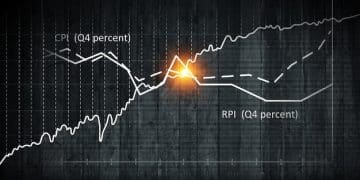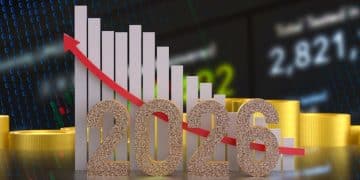New Corporate Tax Rate 2025: Impact on US Business Investments

The potential impact of a new corporate tax rate in 2025 on US business investments is a complex issue, with economists and industry leaders debating whether higher taxes could stifle growth or if other factors, such as market stability and innovation, will prove more influential in driving investment decisions.
The landscape of corporate taxation is a perennial concern for businesses, economists, and policymakers alike. As 2025 approaches, discussions around a potentially new corporate tax rate in the United States are gaining traction, raising critical questions about how such changes might influence investment decisions and the broader economic climate. Understanding the nuances of this debate is crucial for anyone navigating the complexities of the modern business world. This article explores whether is the new corporate tax rate impacting US business investments in 2025 and how it could reshape the American corporate landscape.
Understanding the Proposed Corporate Tax Changes for 2025
The discussion surrounding a new corporate tax rate for 2025 is not unilateral; it’s a significant element of broader fiscal policy proposals. Historically, shifts in corporate taxation have been utilized as instruments to stimulate or cool down economic activity, with varying degrees of success and unforeseen consequences. The proposed changes are often anchored in economic theory, aiming to either increase government revenue, foster domestic investment, or rebalance wealth distribution. However, the exact contours of these proposals remain subject to rigorous debate and political negotiation.
Delving into the specifics, current legislative proposals frequently suggest an upward adjustment to the federal corporate income tax rate, potentially reversing some components of the Tax Cuts and Jobs Act (TCJA) of 2017. Proponents argue that a higher rate could fund critical public infrastructure projects, social programs, or reduce the national debt. Conversely, critics express concerns that such an increase could disincentivize domestic investment and place US companies at a disadvantage in the global marketplace, where many nations compete fiercely for corporate capital through lower tax burdens.
Historical Context and Previous Reforms
Before analyzing the potential impact of future changes, it’s essential to glance at the past. The TCJA dramatically lowered the federal corporate tax rate from 35% to 21%, a move intended to boosts domestic investment, repatriation of foreign earnings, and job creation. The economic outcomes of the TCJA have been a subject of ongoing study, with some analyses suggesting a positive, albeit modest, effect on investment, while others argue that benefits largely accrued to shareholders through stock buybacks rather than tangible capital expenditures. These historical outcomes serve as crucial data points for predicting the ramifications of any new tax regime.
- The Tax Reform Act of 1986: Reduced the top corporate rate from 46% to 34%, broadening the tax base and simplifying the tax code.
- The TCJA of 2017: Signficantly cut the corporate rate to 21%, aiming to enhance competitiveness and stimulate growth.
- Proposed 2025 Changes: Debates center on increasing the rate, possibly to 25% or 28%, alongside adjustments to other tax provisions.
The political climate leading up to 2025 will also play a pivotal role. The legislative process is inherently dynamic, influenced by electoral cycles, shifting economic conditions, and public opinion. Therefore, the final form of any corporate tax reform may differ substantially from initial proposals, making preemptive strategizing for businesses a complex but necessary endeavor. Understanding these dynamics is the first step in assessing whether is the new corporate tax rate impacting US business investments in 2025 will translate into a significant economic shift.
Direct Economic Impact: Investment and Capital Allocation
A change in the corporate tax rate alters the after-tax profitability of investments, which is a fundamental driver for businesses considering capital expenditures. When the tax rate increases, the net return on an investment decreases, making some projects less attractive. This can, in theory, lead to a reallocation of capital, potentially reducing overall investment in the US or shifting it towards less tax-sensitive areas. Businesses might prioritize investments with quicker returns or explore international markets where tax regimes are more favorable.
Impact on Domestic vs. Foreign Investment
One of the primary concerns with raising the US corporate tax rate is its potential to influence the balance between domestic and foreign investment. If the US rate becomes significantly higher than that of other major economies, multinational corporations might opt to allocate more of their capital investments abroad. This “tax arbitrage” can lead to job losses and reduced economic growth within the US. Conversely, proponents of a higher tax rate argue that domestic market stability, a skilled workforce, and robust legal frameworks often outweigh marginal tax differences for many long-term investments.
- Decreased attractiveness of US-based projects: Higher taxes potentially reduce the net present value of domestic investment opportunities.
- Increased capital outflow: Companies might seek lower-tax jurisdictions for new factories, R&D centers, and expansion.
- Potential for “tax inversions”: Though less common now, companies could consider reincorporating abroad to avoid higher US rates.
The responsiveness of investment to tax changes is a frequently debated topic among economists. Some studies indicate a strong correlation, while others suggest that factors like market demand, technological innovation, and regulatory stability play a more significant role. Therefore, while a higher tax rate is a disincentive, it is rarely the sole determinant of investment decisions. Businesses will weigh the increased tax burden against other competitive advantages the US market might offer, as they consider whether is the new corporate tax rate impacting US business investments in 2025 in a detrimental way.
Sector-Specific Vulnerabilities and Opportunities
The impact of a new corporate tax rate will not be uniform across all sectors of the US economy. Certain industries, due to their capital intensity, reliance on specific types of R&D, or exposure to international competition, might experience disproportionate effects. Understanding these sector-specific vulnerabilities and opportunities is crucial for stakeholders to prepare for potential shifts in the investment landscape.

Industries such as manufacturing, which typically require substantial upfront capital for machinery and facilities, could feel a more immediate squeeze from a higher tax rate. Their long investment cycles mean that changes in after-tax returns can significantly alter the viability of new projects. Similarly, sectors heavily reliant on research and development (R&D), like biotechnology and software, often depend on tax incentives for innovation. Any alterations to R&D tax credits or deductions, alongside a higher base rate, could influence their investment in future technologies.
High-Growth vs. Mature Industries
High-growth industries, often characterized by rapid expansion and reinvestment of earnings, might also face challenges. While these companies often prioritize market share and innovation over immediate profitability, a higher tax burden could slow their reinvestment cycles, potentially stifling their growth trajectory. In contrast, mature industries with stable cash flows and less aggressive growth plans might absorb a tax increase with less dramatic shifts in their overall investment strategy, though their after-tax profits would still be reduced.
- Manufacturing: Highly capital-intensive, sensitive to changes in depreciation rules and overall corporate income tax.
- Technology & R&D: Relies on R&D tax credits; higher rates could reduce the incentive for innovation spending.
- Service Industries: Generally less capital-intensive, but impacts on consumer spending could indirectly affect investment.
Conversely, some sectors might find new opportunities or be less affected. Industries that primarily serve domestic markets and have less exposure to international tax arbitrage could be less vulnerable. Furthermore, if the tax revenue from higher corporate rates is reinvested into areas that benefit specific sectors—such as infrastructure spending benefiting construction or transportation—then some negative impacts could be mitigated. The critical question for each sector will be a thorough analysis of how these changes specifically intersect with their unique operational and financial structures, determining how is the new corporate tax rate impacting US business investments in 2025 for them directly.
The Role of Tax Incentives and Deductions
While the headline corporate tax rate often grabs the most attention, the intricate web of tax incentives, deductions, and credits plays an equally, if not more, significant role in shaping business investment decisions. These provisions can substantially reduce a company’s effective tax rate, influencing the attractiveness of various investment opportunities regardless of the statutory rate. Discussions around a new corporate tax rate are rarely isolated; they often accompany proposed adjustments to these incentive structures.
For instance, accelerated depreciation rules allow businesses to deduct the cost of assets more quickly, effectively deferring tax payments and increasing the present value of tax savings. If new tax legislation reduces or eliminates such provisions, even a modest increase in the statutory rate could have a magnified negative impact on capital investments. Similarly, credits for R&D, renewable energy, or job creation are powerful motivators. Any reform effort that aims to increase the corporate tax rate might simultaneously offer new or enhanced incentives to counteract potential deterrents to investment.
Targeted Tax Breaks and Economic Goals
Policymakers often use targeted tax breaks to achieve specific economic goals, such as stimulating growth in particular industries or regions, encouraging green energy initiatives, or boosting employment. As such, any new corporate tax regime for 2025 could introduce new incentives designed to funnel investment into areas deemed strategically important. Businesses will need to carefully track these potential changes, as they could unlock new avenues for investment or alter the risk-reward profile of existing projects.
- R&D Tax Credits: Crucial for innovation-driven sectors; any reduction could slow technological advancement.
- Investment Tax Credits (ITCs): Often used to encourage investments in specific areas like renewable energy or manufacturing equipment.
- Qualified Opportunity Zones: Provide tax incentives for investments in economically distressed communities.
The complexity arises because these incentives are not static and are frequently subject to political horse-trading. Companies planning long-term investments must not only anticipate the nominal tax rate but also forecast the stability and availability of these critical deductions and credits. The interplay between the headline rate and the underlying incentives will ultimately determine the true cost of capital for businesses and, by extension, profoundly influence whether is the new corporate tax rate impacting US business investments in 2025 through these indirect mechanisms.
Investor Confidence and Market Response
Corporate tax rates aren’t just about direct financial calculations; they also significantly influence investor confidence, which can have ripple effects across financial markets and real economy investment. Investor sentiment is a delicate balance of perceived risk, expected returns, and overall economic stability. A sudden or substantial change in corporate tax policy can disrupt this balance, leading to market volatility and a cautious approach to new investments.
When investors perceive a policy change as detrimental to corporate profitability, they may reallocate capital from affected stocks or industries. This can depress stock prices, increase the cost of equity financing, and make it harder for companies to raise capital for expansion. Conversely, if a tax reform is seen as stable, predictable, and supportive of long-term growth, it can bolster confidence, leading to increased capital inflows and a more favorable investment climate. The key for policymakers is to articulate a coherent and long-term vision that reduces uncertainty and provides a clear framework for businesses to plan effectively.
Impact on Publicly Traded Companies and IPOs
Publicly traded companies, which rely on investor sentiment to maintain their valuations and facilitate equity offerings, are particularly sensitive to corporate tax changes. A higher tax rate could reduce earnings per share, making their stock less attractive and potentially hindering their ability to fund growth through public markets. This could also affect the landscape for initial public offerings (IPOs), as companies considering going public might delay their plans or seek less taxing environments if the perceived after-tax returns are diminished.

- Stock market volatility: Tax uncertainty can lead to short-term market fluctuations and reduced trading volumes.
- Cost of capital increase: Lower investor confidence can raise the cost of both equity and debt financing for businesses.
- Delayed M&A activity: Companies may postpone mergers and acquisitions if the post-tax synergy benefits are unclear or reduced.
The messaging around any potential tax rate changes is therefore as critical as the changes themselves. Clear communication, a phased implementation, and a focus on long-term economic stability can help mitigate adverse market reactions. Without these, even economically sound policy decisions could inadvertently dampen investor enthusiasm, demonstrating how crucial it is to consider how broader market sentiment contributes to whether is the new corporate tax rate impacting US business investments in 2025 and beyond.
Competitive Landscape and Global Tax Trends
In an increasingly interconnected global economy, US corporate tax rates do not exist in a vacuum. They are critically benchmarked against those of other major economic powers, influencing the competitiveness of US businesses on the international stage. As countries worldwide grapple with their fiscal responsibilities and compete for corporate capital, understanding these global tax trends is essential for fully grasping the potential impact of any new US corporate tax rate in 2025.
Many nations have lowered their corporate tax rates over the past few decades to attract foreign direct investment (FDI) and stimulate domestic growth. This “race to the bottom” has created a highly competitive environment where even a few percentage points difference in tax rates can influence where multinational corporations choose to set up operations, conduct R&D, or locate their intellectual property. If the US were to significantly raise its corporate tax rate without corresponding shifts in other leading economies, it risks placing its domestic companies at a competitive disadvantage.
OECD’s Global Minimum Tax Initiative
A significant development in global tax policy is the Organization for Economic Cooperation and Development’s (OECD) initiative for a global minimum corporate tax rate. This framework, agreed upon by over 130 countries, aims to ensure that multinational corporations pay a minimum effective tax rate, generally set at 15%, regardless of where they operate. The goal is to curb profit shifting to low-tax jurisdictions and ensure a fairer distribution of tax revenues.
- Reduced “Race to the Bottom”: The global minimum tax could standardize corporate taxation to some extent, reducing the incentive for countries to lower rates dramatically.
- New revenue streams: For countries where companies pay less than the minimum, signatory nations could collect top-up taxes.
- Complexity for multinationals: Companies will need to navigate new, potentially complex, international tax rules.
The global minimum tax initiative introduces a fascinating dynamic. While it aims to level the playing field, the specifics of its implementation and its interaction with individual national tax reforms, including any new US corporate tax rate, remain subject to interpretation and ongoing negotiation. For US businesses, this means that even if the domestic rate rises, the overall global tax environment might become more harmonized, potentially mitigating some of the competitive disadvantages. Therefore, when assessing whether is the new corporate tax rate impacting US business investments in 2025, it’s crucial to consider this broader international context alongside domestic policy.
Mitigation Strategies for Businesses
Faced with the prospect of new corporate tax rates in 2025, businesses are not without recourse. Proactive planning and strategic adjustments can help mitigate potential negative impacts and even uncover new opportunities within the shifting tax landscape. The key lies in understanding the proposed changes early, assessing their specific implications, and developing agile financial and operational strategies.
One primary strategy involves a thorough review of investment portfolios and capital allocation plans. Companies should conduct scenario analyses, modeling the impact of various proposed tax rates and incentive structures on their projected returns. This allows for early identification of projects that might become less viable and helps prioritize those that remain robust under new tax conditions. Furthermore, businesses might explore diversifying their investment geography, though domestic opportunities often offer inherent advantages in terms of market familiarity and operational control.
Optimizing Tax Planning and Compliance
Effective tax planning and robust compliance mechanisms become even more critical during periods of tax reform. This includes maximizing eligible deductions and credits, ensuring accurate reporting, and potentially restructuring to optimize for the new environment. Engaging with tax advisors and legal counsel knowledgeable about both domestic and international tax laws is paramount to navigate complexities and ensure adherence to evolving regulations.
- Capital Expenditure Timing: Accelerating planned investments before a potential tax increase or delaying them if new incentives are anticipated.
- Supply Chain Review: Evaluating supply chain structures to optimize tax efficiency, especially for multinational corporations.
- R&D Focus: Prioritizing R&D activities that qualify for tax credits and exploring new technologies that align with potential green or innovation incentives.
Moreover, active engagement with policymakers and industry associations can provide businesses with a voice in the legislative process and offer insights into the direction of future tax policy. By contributing to the discourse, companies can help shape reforms that better balance national fiscal needs with the imperative for economic growth and investment. Ultimately, while the new corporate tax rate in 2025 presents challenges, a strategic and informed approach can help businesses adapt and maintain their growth trajectory, ensuring they stay ahead of the curve as they consider whether is the new corporate tax rate impacting US business investments in 2025.
| Key Point | Brief Description |
|---|---|
| 📈 Investment Impact | Higher corporate taxes can reduce after-tax returns, potentially slowing domestic capital expenditures. |
| 🌐 Global Competition | US rates benchmark against global trends; significant differences could shift investment abroad. |
| 💡 Incentives Matter | Tax deductions and credits are as crucial as the headline rate in shaping investment decisions. |
| 🛡️ Mitigation Strategies | Businesses can proactively plan, optimize tax structures, and time capital expenditures to adapt. |
Frequently Asked Questions About 2025 Corporate Tax Rates
A corporate tax rate is the percentage of a company’s profits paid to the government. It’s often changed due to shifts in governmental fiscal priorities, economic conditions, or political mandates. Proposed changes for 2025 aim to potentially increase revenue for public spending or address wealth distribution, reversing some previous tax cuts.
The impact on smaller businesses depends on their profitability structure and existing tax liabilities. While some may face increased tax burdens, many smaller businesses are structured as pass-through entities (e.g., S-corps, partnerships), meaning their profits are taxed at individual income tax rates rather than corporate rates. However, indirect effects on overall economic sentiment and consumer spending could still apply.
A higher US corporate tax rate could make the US less attractive for new foreign direct investment compared to countries with lower tax burdens. However, other factors like market size, stability, skilled labor, and regulatory environment also heavily influence foreign investment decisions. The global minimum tax initiative by the OECD might also mitigate some of these effects by harmonizing rates.
Tax incentives are special provisions, such as deductions, credits, or exemptions, that reduce a company’s tax liability. They are often used by governments to encourage specific behaviors like research and development, job creation, or investments in certain industries. These incentives can significantly lower a company’s effective tax rate, making some investments viable even if the statutory corporate tax rate is high.
Businesses can prepare by conducting comprehensive scenario planning, analyzing how various tax rate adjustments and incentive changes would affect their financials. Proactive engagement with tax advisors, optimizing capital allocation strategies, and reviewing supply chains for tax efficiency are also crucial steps. Staying informed about legislative developments and industry trends is key to adapting effectively.
Conclusion
The question of whether a new corporate tax rate will impact US business investments in 2025 is multi-faceted, with no simple answer. While a higher tax rate could, in isolation, reduce the after-tax profitability of investments and potentially disincentivize capital allocation in the US, the reality is far more nuanced. The interplay of specific tax incentives, the broader global tax landscape including initiatives like the OECD’s global minimum tax, and the prevailing investor confidence will all play significant roles. Businesses will need to remain agile, strategically review their financial and operational structures, and engage actively with changing policy. Ultimately, the true impact will depend not only on the rate itself but on the comprehensive package of tax reforms, global economic conditions, and the adaptive strategies employed by businesses to navigate this evolving fiscal environment. Careful monitoring and proactive planning will be essential for sustained growth and competitiveness.





